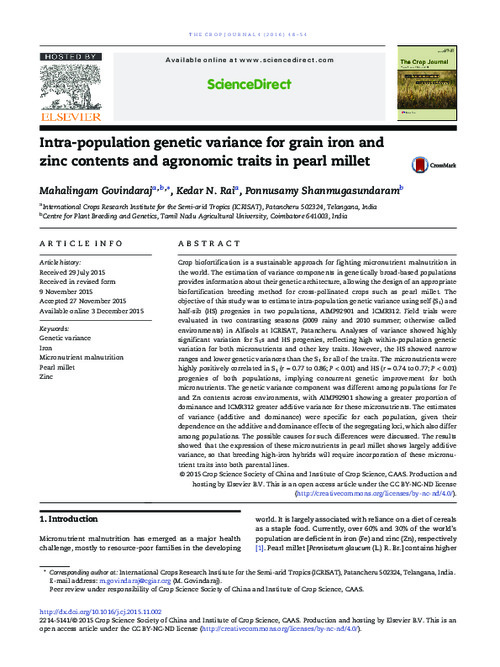Intra-population genetic variance for grain iron and zinc contents and agronomic traits in pearl millet
Abstract
Crop biofortification is a sustainable approach for fighting micronutrient malnutrition in
the world. The estimation of variance components in genetically broad-based populations
provides information about their genetic architecture, allowing the design of an appropriate
biofortification breeding method for cross-pollinated crops such as pearl millet. The
objective of this study was to estimate intra-population genetic variance using self (S1) and
half-sib (HS) progenies in two populations, AIMP92901 and ICMR312. Field trials were
evaluated in two contrasting seasons (2009 rainy and 2010 summer; otherwise called
environments) in Alfisols at ICRISAT, Patancheru. Analyses of variance showed highly
significant variation for S1s and HS progenies, reflecting high within-population genetic
variation for both micronutrients and other key traits. However, the HS showed narrow
ranges and lower genetic variances than the S1 for all of the traits. The micronutrients were
highly positively correlated in S1 (r = 0.77 to 0.86; P < 0.01) and HS (r = 0.74 to 0.77; P < 0.01)
progenies of both populations, implying concurrent genetic improvement for both
micronutrients. The genetic variance component was different among populations for Fe
and Zn contents across environments, with AIMP92901 showing a greater proportion of
dominance and ICMR312 greater additive variance for these micronutrients. The estimates
of variance (additive and dominance) were specific for each population, given their
dependence on the additive and dominance effects of the segregating loci, which also differ
among populations. The possible causes for such differences were discussed. The results
showed that the expression of these micronutrients in pearl millet shows largely additive
variance, so that breeding high-iron hybrids will require incorporation of these micronutrient
traits into both parental lines

